skip to main |
skip to sidebar
The Northern City Line is a short branch line in London with an interesting history.
History
The Great Northern and City Railway (GN&CR) was formed in 1892 to build an underground electric railway from Finsbury Park, on the Great Northern Line, to Moorgate Street in the City of London. Initially, the Great Northern Railway supported the scheme and, to allow through running of main-line stock, the double-track line was built mainly in twin 'tube' tunnels, each with a diameter of sixteen feet. However, problems financing the project combined with disagreements over joint operations meant that the line as built terminated in underground platforms at Finsbury Park underneath the Great Northern Railway station.
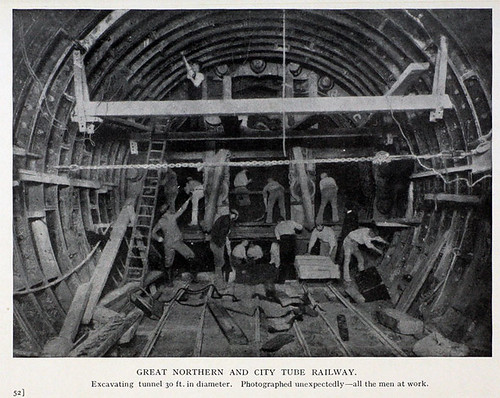
Great Northern and City Railway - driving 30 foot diameter tunnel section (Photo: Grace's Guide).
The line opened in February 1904 over a distance of three and a half miles from Finsbury Park to Moorgate in the city of London. Although powers had been obtained in 1902 to extend from the southern terminus around 500 yards to the Bank of England, this plan was abandoned after only part of the tunnel had been constructed. The isolated nature of the line prevented the railway from running at a profit but it was successful enough to be acquired by the Metropolitan Railway in 1913. In 1933, London Passenger Transport Board took control and the line became an isolated section of the Northern Line, called the 'Northern City Line'. It would have formed part of the proposed 'Northern Heights Extension' but this scheme was abandoned.
In 1964, Drayton Park became the northern terminus, allowing the original underground platforms at Finsbury Park to be used by the Victoria Line then being constructed. Highbury & Islington station was remodelled to allow interchange between the new Victoria Line and the Northern City Line. In 1970, the line was renamed 'Northern Line - Highbury Branch'. Around 1975, London Underground agreed to transfer the line to British Railways. However, before London Underground withdrew the service, Moorgate was the site of the worst London Underground train accident on 28-Feb-1975, killing 42 passengers and the driver. The excellent Railways Archive site has a summary of the report on this accident here, with a link to the full report which is well worth studying to understand the meticulous investigations carried out after major accidents.
British Railways Eastern Region converted the line from Drayton Park to Moorgate for their use, with 750 volt d.c. third-rail electrification and provided a connection from Drayton Park to the surface station at Finsbury Park, with 25 kV a.c. overhead electrification allowing the Moorgate Branch to form part of the Great Northern Suburban Electrification Scheme, finally realising the ambitions of the promoters of the Great Northern and City Railway in 1892! In 1976, services commenced to Welwyn garden City and Hertford north, extended to Royston in 1978. At that time, the Electrification Control Room (ECR) supervising the area was at Hornsey.
There's an interesting PDF by the London Underground Railway Society celebrating 110 years of the Northern City Line 110 YEARS OF THE GREAT NORTHERN & CITY published by here.
Rolling Stock
Electric Multiple Units were used from the opening in 1904, built by Brush (Loughborough) and The Electric Tramway & Carriage Works (Preston). By 1939, these units had been withdrawn and normal tube stock was in use.
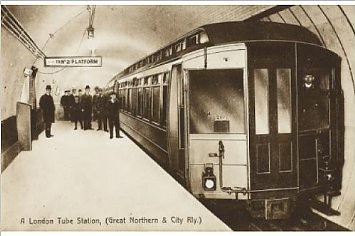
Original rolling stock on Great Northern and City Railway.
Since 1976, the line has been operated by dual-voltage class 313 EMUs running on the third rail system with tripcocks over the tunnel section and the overhead line equipment north of Drayton Park station. The EMU are arranged as 3-car sets with two driving motor cars and a trailer car. In peak periods, two 3-car sets work in multiple. Each motor car is equipped with four GEC G310AZ 82.125kW motors. For more information, see the Wikipedia article here.
This rolling stock is about to be replaced by a variant of the Class 700 'Desiro City' dual-voltage Electric Multiple Units, the Class 717 which is fitted with end doors for use on the Northern City Line, allowing passengers to be evacuated via the Moorgate Tunnel (as is possible with the 40-year old Class 313). At a recent Rail Industry Information Day (described here), I was surprised to find a full-sized Class 717 cab.
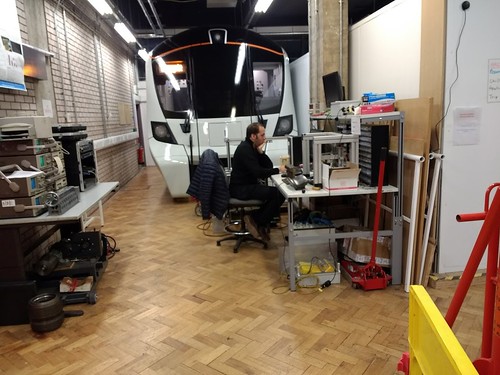
Rail Industry Information Day, 2018: Class 717 cab.
Electricity supply
Originally, power for the Northern City Line was produced at a dedicated generating station on the surface at Poole Street, roughly halfway along the route, directly above the twin tunnels. As mains electricity became available, the generating station was closed, being replaced by two traction sub-stations located at Finsbury Circus (adjacent to Moorgate station) and Queensland Road (adjacent to Drayton Park station). Around 1920, the abandoned generating station at Poole Street was converted into film studios for Gainsborough Films. At the time of my own first visit during a survey in 2006, the site was being re-developed as apartments.
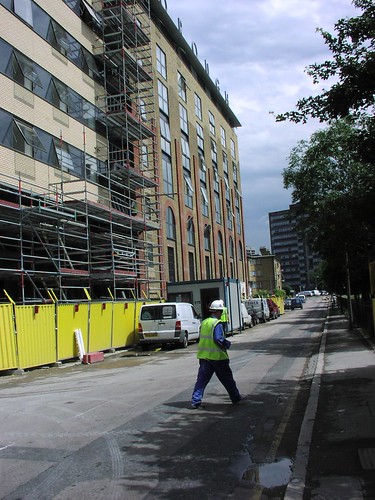
Former Gainsborough Studios, pictured during conversion into apartments (Photo: Thales).
Current was originally supplied at 575 volts d.c. using a fourth-rail system with each conductor rail placed outside the adjacent running rail (as on the Earl's Court experimental electrified train). By 1939, the conductor rail system had been converted to the standard London Underground fourth-rail system, as described in the posts London Underground - Traction Power Distribution and Fourth Rail Electrification. Transmission losses at 750 volts d.c. are relatively high and, to avoid excessive voltage drop, Traction Sub Stations (TSS) have to be located quite close together. When British Railways took over the Northern City Line, in addition to converting current collection to third rail, the power supply was upgraded. The conductor rail is divided into traction sections extending from one TSS to the next. Each section is double-end fed with d.c. from rectifiers at both Traction Sub Stations, to help to minimise voltage drop, particularly when more than one train is in a traction section.
Traction Sub-stations
The practical arrangement of a typical TSS with two rectifiers is illustrated in Figure 2.2 below. TSS for third rail conductor systems, are simpler than for the London Underground fourth-rail systems, since circuit breakers only need to switch the feed to the conductor rail.

The substation has two d.c. busbars linked or isolated by a coupling breaker. Each rectifier and each road supplied is associated with a circuit breaker. At most TSSs, the coupling breaker is normally closed so that both rectifiers and all four roads are connected together to minimise voltage drop. The TSS at Finsbury Circus and Queensland Road are simpler than the diagram, since each TSS only controls two traction sections.
Track Paralleling Huts
At some locations, Track Paralleling Huts (TPH) may be provided, rather than a full TSS. Each conductor rail is broken to form a section gap, but normally circuit breakerss are closed to connect together all conductor rails. Again, the aim is to reduce the voltage drop as a number of rectifiers can contribute current to each traction section. The arrangement is shown in Figure 2.3 below.

Jan's involvement
In 1974 my firm supplied an Electrification Telephone system for the 25 kV a.c. overhead electrified parts of the Great Northern Suburban Electrification Scheme, controlled from an Electrification Control Room (ECR) at Hornsey, as briefly mentioned in the post Electrification Telephone Systems for British Rail. This system extended as far south as Drayton Park but the tunnel section to Moorgate (being third rail d.c. electrified) was outside our scope and British Rail at York provided equipment for this section.
As described in the post London Underground and Jan, it was some twenty years later that my firm became involved in Tunnel Telephones for London Underground. As a result of our work with London Underground, in 2006 Thales contacted us regarding replacement of the life-expired tunnel telephone equipment on the Northern City Line.
The Northern City Line operates with a Traction Sub Station (TSS) at either end of the tunnel, with a midway Track Paralleling Hut (TPH) underground at Poole Street. Whilst the tunnel telephone system on the Northern City Line serves a similar emergency traction discharge function to London Underground systems, it also provides Signal Post Telephone functionality. Trying to understand the detailed functionality required was not helped by the fact that the late, unlamented Railtrack had managed to destroy most of the technical records of the earlier British Railways Eastern Region system, which used 3000-type Post Office relays. This equipment was located in an underground equipment room at Poole Street, accessed by a 50-foot descent from the surface via a steel ladder with safety landings set in a vertical shaft! We produced new equipment developed from our designs for London Underground and a re-configured layout moving the equipment to an existing telecommunications equipment room on the surface at Finsbury Park, providing easier maintenance access. The notes on the re-configured system below are derived from training material prepared by Ford Electronics Limited, with permission.
Notes on the re-configured system
The third-rail conductor system on the Northern City Line consists of a conductor rail laid along the track route allowing power to be picked up continuously by the train through its shoegear equipment. The conductor rail is laid outside the running rails and supported on porcelain insulators at a maximum pitch of around 4.3 metres. At turnouts, crossings and section gaps the conductor rails are broken. Ramps at the start of the conductor rail section lift the train collector shoes onto the rail and similar ramps at the end lower the shoes from the rail. The length of the gap depends upon the track feature. One of the two running rails is used as a traction current return, unlike the standard London Underground arrangement which also has a return conductor rail arranged for shoegear. However, Northern City Line does have a ‘fourth rail’ in the tunnel, spiked to the sleepers in between the running rails and frequently cross-bonded to the traction return running rail. This ‘fourth rail’ is not a contact rail but an additional return conductor which reduces losses and helps to reduce unwanted earth currents.
Traction Power Distribution
Two independent 11kV incoming supplies are introduced at Poole Street TPH and an 11kV ring main located in the rail tunnel distributes the power to TSS at each end of the tunnel section, one at Queensland Road (adjacent to Drayton Park station) and one at Finsbury Circus (adjacent to Moorgate station) where the 11kV is transformed and rectified to feed 750 volts d.c. to the conductor rails. At each TSS two Hackbridge and Hewittic fan-cooled silicon rectifiers rated at 750/630V 1,780kW are provided. The traction sections on both the up and down lines are divided at Poole Street, where a TPH is provided to minimise voltage drop. The track feeds at the TSSs and TPH are via Whip and Bourne high-speed d.c. circuit breakers, similar to London Underground practice but without a negative contactor. These circuit breakers allow individual traction sections to be discharged. Both TSS and the TPH are remotely controlled from the Electrification Control Room, now located at York.
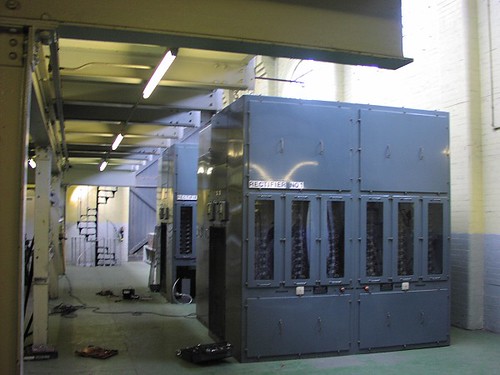
Traction Rectifiers in Queensland Road Sub-station, Northern City Line.
Control of circuit breakers
The four high speed circuit breakers in the TPH at Poole Street and the two high speed circuit breakers at Queensland Road and the two high speed circuit breakers at Finsbury Circus are controlled from local Slave Relay Units. In each case, the final interface to the high speed circuit breaker from the Slave Relay Unit is a BR930 relay contact which opens to discharge the traction section. This contact operates a D2600 interface relay (produced by Signature Industries, formerly Clifford and Snell) within the high speed circuit breaker from a nominal 50 volt d.c. supply provided by the d.c. switchboard. The Slave Relay Units are controlled over telecommunications cable from the Tunnel Telephone Cubicle at Finsbury Park.
Tunnel Telephone/Signal Post Telephone Tunnel Wires
In tunnel sections of the system, a Tunnel Telephone system provideds traction discharge and voice communication between the driver and Signaller at Kings Cross. Traction trip and speech is provided over two bare copper alloy wires carried, one above the other, on pairs of porcelain insulators supported on metal brackets fixed to the tunnel wall. The insulators are generally provided every 6 metres along the tunnel so as to keep the wires about 115mm apart. The wires are positioned so as to be accessible by leaning from the driving cab window of a train. The tunnel wires are divided into 20 sections so as to provide each colour light running signal with a dedicated speech circuit to the Signaller.
Trainborne equipment
Portable tunnel telephones are mounted in the cabs of all EMU which work over the line. They incorporate DTMF (Dual Tone Multiple Frequency) calling to the signaller and a means of shorting the circuit so as to discharge the traction supply. Pressing and holding either yellow button automatically sends a short burst of DTMF tone, after which speech is possible. The duplicated pushbutton makes the handset suitable for left-handed and right-handed users. Pressing the red ‘ISOLATE’ button places a low resistance across the tunnel wires, in order to discharge the traction supply. Alternately, Traction current may be discharged by simply 'pinching' together the two tunnel wires.

Tunnel Telephone used by Drivers to discharge traction or talk to the Signaller.
Tunnel Telephone/Signal Post Telephone Equipment Cubicle, Finsbury Park
A 2-metre high enclosed equipment cubicle is provided in the Telecommunications Equipment Room at Finsbury Park, together with a battery-backed power supply providing nominal 24 volt d.c. for the Tunnel Telephone equipment.

Northern City Line Tunnel Telephone system: Equipment Cubicle at Finsbury Park Telecommunications Equipment Room.
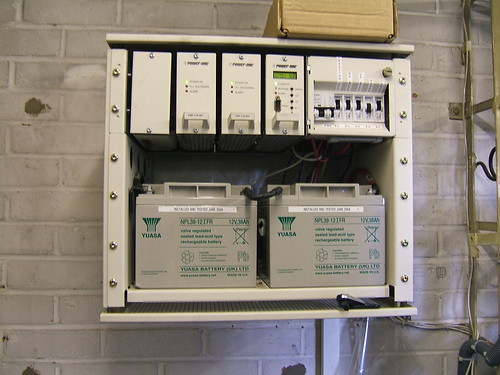
Northern City Line Tunnel Telephone system: Power supply at Finsbury Park Telecommunications Equipment Room.
The main telecommunications cables for the East Coast Main Line pass through a Distribution Frame in the Telecommunications Equipment Room, allowing simple cross-jumpering of the Northern City Line Tunnel Telephone circuits across to pairs leading to the controlling signal box at King's Cross.
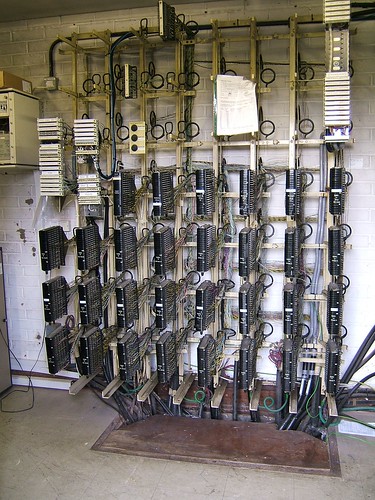
Northern City Line Tunnel Telephone system: Main Distribution Frame at Finsbury Park Telecommunications Equipment Room.
King's Cross Power Signal Box
The control of the Northern City Line was provided from King's Cross Power Signal Box (now planned for closure with control transferred to York Railway Operating Centre). At King's Cross, the Supervisor’s desk had a reset control panel which allowed York ECR to recharge the conductor rails of the Northern City Line. This was controlled from special Reset and Indication cards in the Telecommunications Equipment Room. Signal Post Telephone calls were processed by special SPT cards in the Telecommunications Equipment Room which detected the DTMF call tone and presented to call to Signallers on the main signalling console.
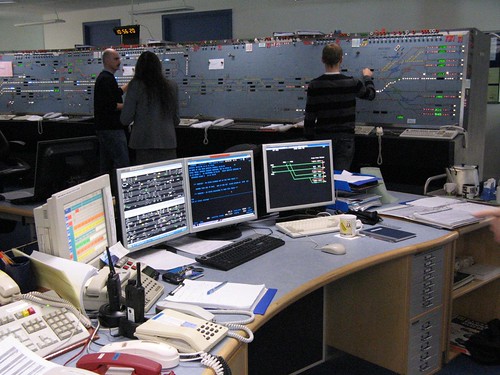
Supervisor's Desk & general view (Photo: Thales).
Related posts on other websites
Although the links worked at the time this post was published, changes made by that website's owner may 'break' the link.
Northern City Line (Wikipedia).
British Rail Class 313 (Wikipedia).
Great Northern and City Railway (Grace's Guide).
110 YEARS OF THE GREAT NORTHERN & CITY (The London Underground Railway Society).
Related posts on this website
London Underground - Traction Power Distribution.
Fourth Rail Electrification.
Electrification Telephone Systems for British Rail.
London Underground and Jan.
Rail Industry Information Day, 2018.
Related photograph albums
Where necessary, clicking on an image above will display an 'uncropped' view or, alternately, pictures may be selected, viewed or downloaded, in various sizes, from the albums listed:-
Northern City Line: 2-Nov-2006.
Kings Cross Power Box.
TTSystem for NCL: Installed System: 21-Oct-2009.
TT System for NCL: Equipment.
TT System for NCL: Testgear: 11-Jun-2009.
On Friday 12th January 2018, I attended the annual RSSB Rail Industry Information Day which was held (outside London for the first time, I think) at the University of Birmingham.
Getting there
I took the first bus from Brewood to Wolverhampton and caught the busy 08:11 Arriva Trains Wales to Birmingham International, getting off at Birmingham New Street. Having some time in hand, I toured the Grand Central shopping area, amazed at the range of food outlets well-patronised by people taking breakfast - coffee shops, juice bars, pizza places, sushi bars, Mexican food, even Korean Street Food! I talked about my reaction to Birmingam's Grand Central in the earlier post here.

Grand Central, Birmingham New Street: Atrium showing retail outlets at both Concourse Level and around the Gallery.
I exited to Stephenson Place to see the temporary terminus of the 'Midland Metro' now that the extension from the original terminus at Snow Hill along Corporation Street to New Street station is, belatedly, in use. A further extension, due to open in 2019, will pass the Town Hall and reach Centenary Square. The rolling stock comprises 21 units of the 'Urbos 3' five-section articulated design built by CAF in Spain. See the Wikipedia article here.
Returning to the station, I was just in time to catch the next Class 323 Electric Multiple Unit on the Cross-City service. The service was taken over by 'West Midlands Trains' on 10-Dec-2017 (as I mentioned in the earlier post A Trip to Merseyside) but, externally, the former 'London Midland' livery is still carried. The Class 323 were built by Hunslet between 1992 and 1995 and, under our crazy arrangements for privatising railways, the trainsets are now owned by Porterbrook which is a 'ROSCO' (rolling stock company). There's a Porterbrook data sheet on the Class 323 here.
The journey only took a few minutes and the University of Birmingham has its own station called, with admirable clarity, 'University' (although the station is equally handy for the huge Queen Elizabeth Hospital). Since I walk slowly these days, it took me 15 or 20 minutes to walk across the large university campus to the venue. The focal point of the university remains the original D-plan grouping of red brick buildings designed by Sir Aston Webb and Ingress Bell built between 1900 and 1909 with its campanile clock tower of tapering square section with a corbelled top stage and lantern, called the 'Joseph Chamberlain Memorial Clock Tower', the 'Chamberlain Clock' or simply 'Old Joe' in honour of the university's first chancellor. There's more on the clock tower in the Wikipedia article here.
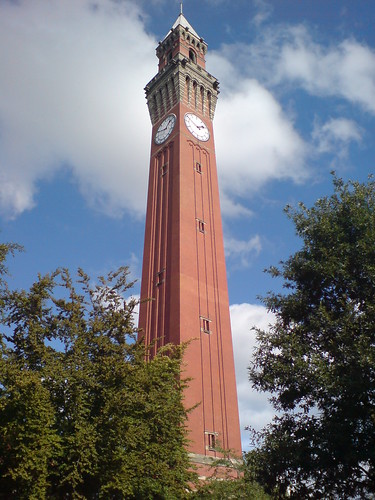
Joseph Chamberlain Memorial Clock, University of Birmingham (Photo: Tomsega, Public Domain).
The initial, unified group of buildings is now surrounded by numerous more modern structures, each of a completely different design reflecting tastes at the time of building.
The venue

Rail Industry Information Day, 2018: Gisbert Kapp Building, University of Birmingham.
The venue was the School of Electronic, Electrical and Control Engineering located in the Gisbert Kapp Building. I had to look up Gisbert Kapp, an Austrian/English electrical engineer born 1852 who held the first Chair of Electrical Engineering at the University of Birmingham from 1904 until his death in 1922. There's a detailed profile in Grace's Guide here.

Gisbert Kapp in 1922 (Photo: Grace's Guide).
The Sponsor
The event was sponsored by the Rail Safety and Standards Board (RSSB), created in 2003 following Railtrack's demise as an independent not-for-profit company limited by guarantee, with a remit to encourage rail research and innovation and creating better links between universities and the rail industry. The University of Birmingham is home to the Birmingham Centre for Railway Research and Education (BCRRE), described here.
The railway industry is now littered with a bewildering array of initiatives and acronyms whose initials were freely used throughout the proceedings. Here are a few:-
RSG (Rail Supply Group)
RDG (Rail Delivery Group)
TLG (Technical Leadership Group)
UKRRIN (UK Rail Research and Innovation Network)
The event
Registration took place on the first floor where refreshments were available in 'The Link', a student Open Learning area closed to students for the day.
 Rail Industry Information Day, 2018: Refreshments in 'The Link'.
Rail Industry Information Day, 2018: Refreshments in 'The Link'.
At 10:15 we were invited to troop to a large, modern lecture theatre on the ground floor. There were almost 100 attendees, over half from the rail industry. Martin Brennan, Head of European Programmes at RSSB, said that the day would review the Horizon 2020 and Shift2Rail Work Programmes and Collaboration funding opportunities available within 80 billion Euros of funding being provided by the European Union (EU) between 2014 and 2020. More information is available here. Within Horizon 2020, Shift2Rail (S2R) is dedicated to railway research, with more information here.
Professor Clive Roberts [Professor of Railway Systems at the University of Birmingham and Director of the Birmingham Centre for Railway Research and Education (BCRRE)] then gave a "virtual tour" of the Railway Centre of BCRRE, one of three centres in the United Kingdom supporting new innovation in rail transport and part of UKRRIN.
Next, Carlo Borghini who is Executive Director of the Shift2Rail Joint Undertaking updated the meeting on the current programme status and future opportunities.
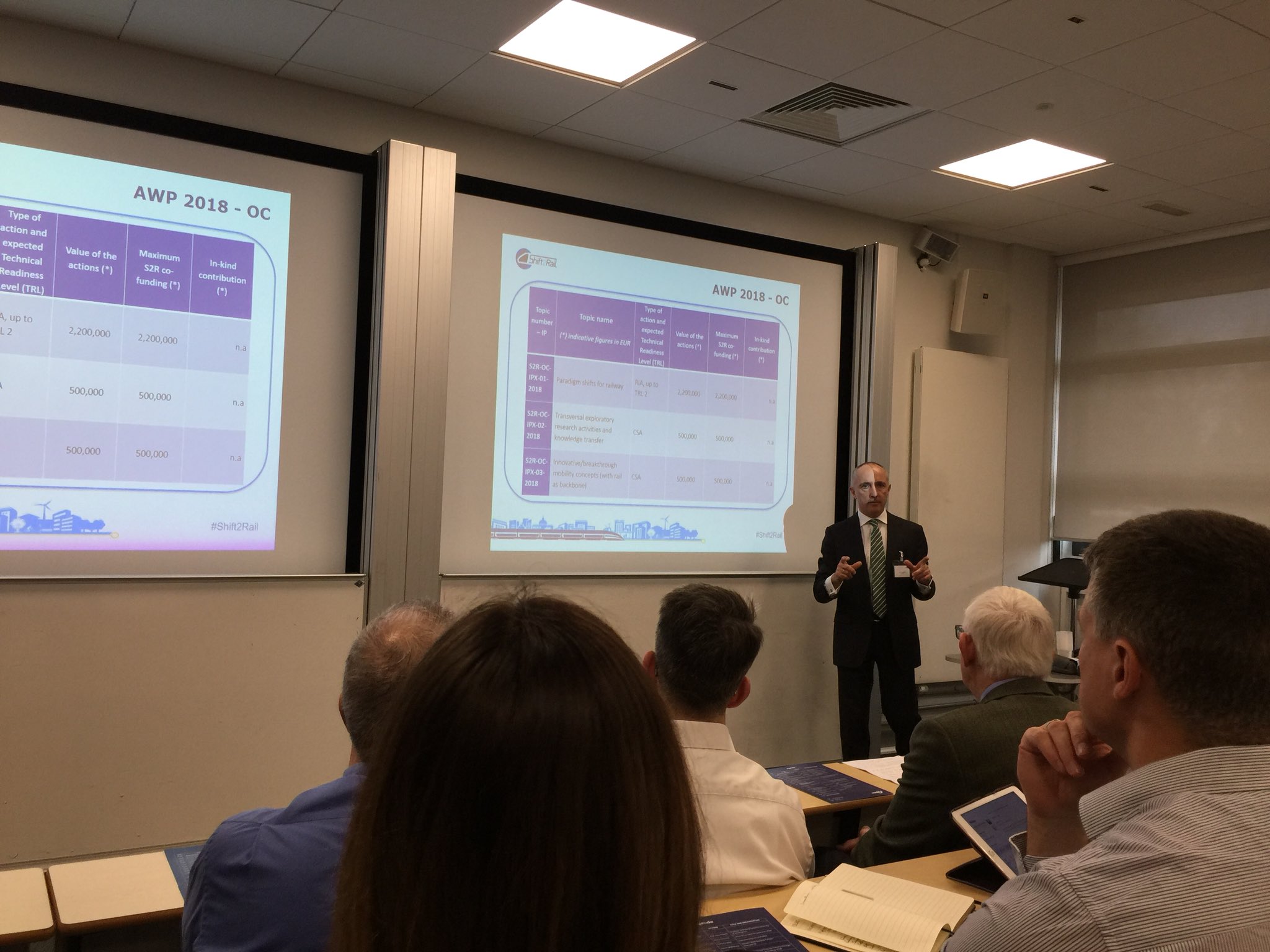
Carlo Borghini addressing Rail Industry Information Day (Photo: Professor Clive Roberts via Twitter).
Louise Mothersole (Horizon 2020 UK National Contact Point for Transport at Innovate UK) explained that the decision of the United Kingdom to leave the European Union did not affect the eligibility of United Kingdom firms seeking to participate in Horizon 2020.
After a coffee break held in The Link, James Hardy talked about RSSB's Rail Technical Strategy. This was followed by a series of 2-minute 'Elevator Pitches' from 12 speakers, after which a buffet lunch was served in 'The Link'.
At 13:45, Martin Brennan described the European Rail Research Advisory Council (ERRAC) which was set up in 2001 to "promote an holistic vision of the European Rail system with all stakeholders" before introducing Professor Simon Iwnicki (Professor of Railway Engineering and Director of the Institute of Railway Research - Huddersfield University) who spoke about participation in Shift2Rail 'Open Call' projects.
Next, Professor Clive Roberts spoke about the S-CODE Project which aims to investigate radically different technology concepts that can be integrated to achieve significantly improved performance for railway Switches and Crossings emphasising successful techniques used in planning this type of project.
A concise explanation of the various funding opportunities under Horizon 2020 and Shift2Rail was given by Louise Mothersole, with an invitation for applicants to contact the National Contact Point for support.
RSSB, in conjunction with Rail Research UK Association, has completed its Rail Technical Strategy Capability Development Plan (RTS CDP). The plan is divided into 12 'Work Packages' to which 'Work Package Owners' have been allocated.

A graphic representing the 12 Work Packages.
Finally, two of the Work Package Owners made short presentations:-
Janine Fountain spoke about Package 02 - Minimal disruption to train service
Karl Butler-Garnham spoke about Package 04 - More value from data
This concluded an interesting day which had given many useful suggestions to prospective applicants.
Railway Centre
As originally planned, the day was to have started with a physical tour of the Railway Centre laboratories but the large number of attendees precluded this, hence the "virtual tour" mentioned above. However, a small group of attendees stayed behind for a tour offered by Doctor Edd Stewart (Lecturer in digital logic and microprocessor systems who also leads on various research projects). An idea of the Research Capability offered by BCRRE can be gained from the website here. Some of the highlights of the tour are outlined below.
A room containing a 14-foot diameter horizontal wheel with a circle of rail on top can be rotated by a 30 kW electric motor to give the effect of a train travelling at 80 km/hour. Chillers can produce freezing conditions in the room, allowing research into railhead de-icing for railways.
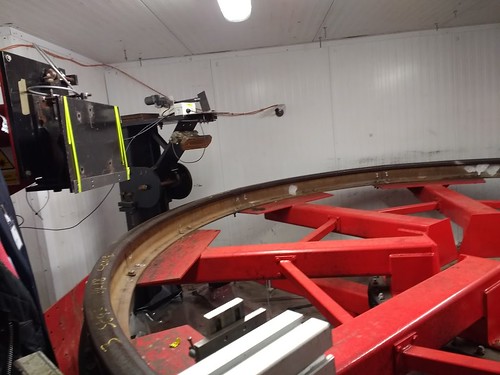
Rail Industry Information Day, 2018: Railhead testing rig.
A well-equipped Railway Control and Operations Simulation room allows research into the next generation of railway traffic management systems.
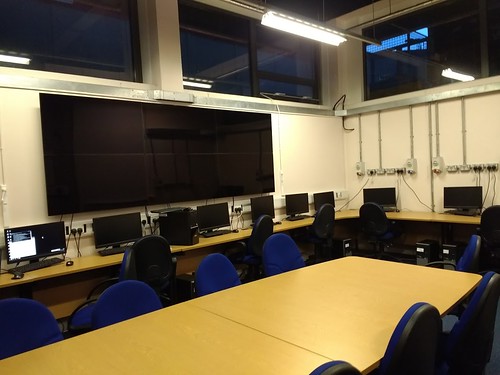
Railway Control and Operations Simulation Room.
In another area, we saw various types of prototype condition monitoring equipment for rolling stock.
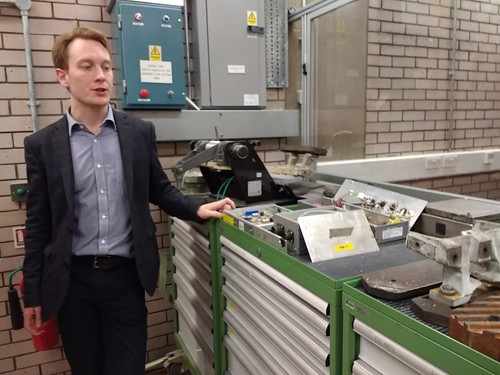
Rail Industry Information Day, 2018: Dr. Edd Stewart with prototype condition monitoring equipment.
We saw the laboratory-based test facility for evaluating and characterising pantograph dynamic loading performance.
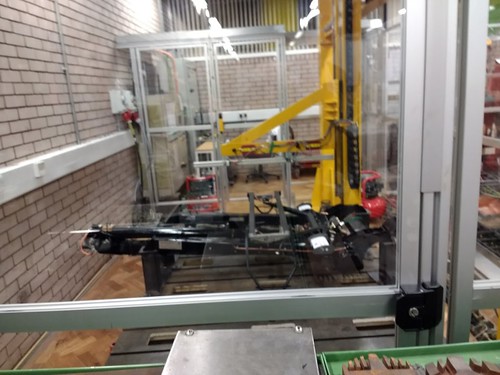
Rail Industry Information Day, 2018: Pantograph test rig.
Nearby, there was a robotic inspection cell for use with railway vehicle wheelsets.
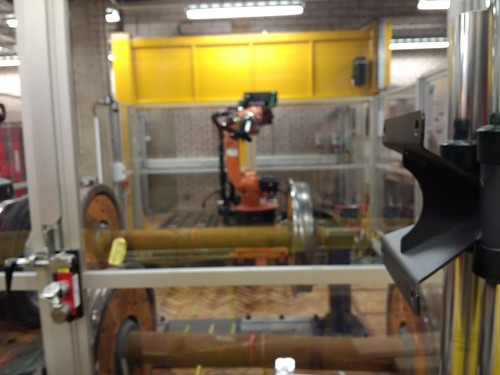
Robotic inspection cell for use with railway vehicle wheelsets.
Another climate chamber held the 'sharp end' of a set of points, allowing the evaluation of point machine performance under varying weather conditions. There was also a small 4-wheel inspection trolley in this chamber, fitted with a robotic arm which can examine the rail head.
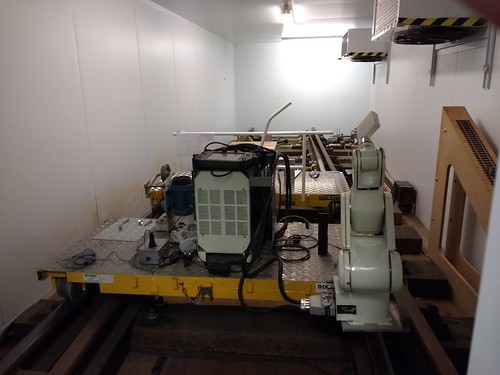
Rail Industry Information Day, 2018: Rail switch test chamber.
A large Motor Generator Set with a programmable load is available for Power Systems and Energy Use research.

Rail Industry Information Day, 2018: Motor Generator Set with a programmable load for Power Systems research.
On our way out, we passed a full-sized cab, which I decided was a Class 717 cab. The Class 700 'Desiro City' are already in use on British Rail. The Class 717 is a variant with end doors for use on the Northern City Line which allows passengers to be evacuated via the Moorgate Tunnel, as is possible with the existing 40-year old Class 313.

Rail Industry Information Day, 2018: Class 717 cab.
Getting back
It only remained to return home by walking back across the darkening Campus, catching a busy Cross-City service to Birmingham New Street, changing to a standing room only Arriva Trains Wales service as far as Wolverhampton and then getting a taxi home (our last bus from Wolverhampton is 17:10!)
Related posts on this website
Rail Research UK Association Annual Conference 2017.
Grand Central and Birmingham New Street Station.
My photograph albums
Where necessary, clicking on an image above will display an 'uncropped' view or, alternately, pictures may be selected, viewed or downloaded, in various sizes, from the albums listed:-
Rail Industry Information Day.
Not exactly 'hot' news, but this report mentions a little hiccup in the history of Liverpool's historic 'Lion Tavern' back in 2016.
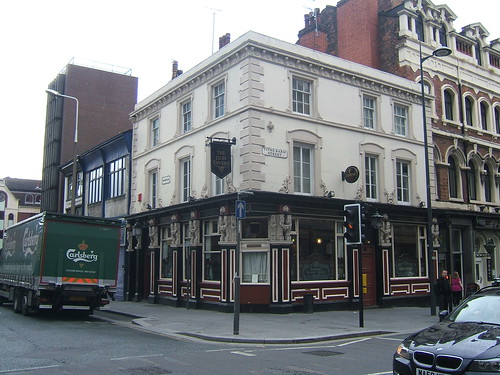
The 'Lion Tavern' has a commanding corner location opposite the former Exchange station.
Because of my involvement with the Old Locomotive Committee (OLCO), I knew of the 'Lion Tavern, located at the junction of Moorfields and Tithebarn Street but I'd never been there until OLCO provided assistance to the Museum of Liverpool in the making of a video about Lion's history. That visit is described in the short post here.
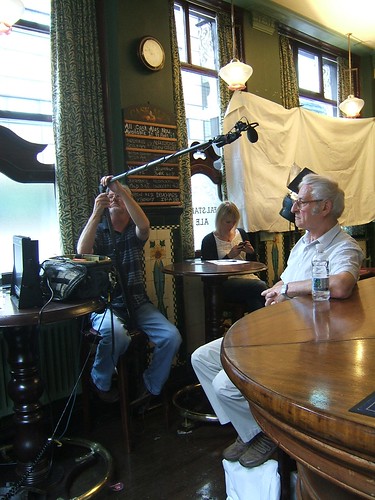
John Hawley does his 'piece to camera'. Sound Recordist Malcolm and Producer Fiona in the background.
Some years after, I came across the Liverpool Echo article from 15th June 2016 "Last orders called at two Liverpool city centre pubs - including the historic Lion Tavern" here.
Later, I found another Liverpool Echo report dated 16th November 2016 proclaiming "The historic Lion Tavern re-opens today" here.
Although I've not been back to the Lion Tavern yet, it seems to be thriving: there's a website here. And the Ale? I'm sorry, during my visit I only took tea.
Regular readers may be aware that the Liverpool area has fascinated me since my early visits as a child. Periodically, I make a day trip there.
In the post Liverpool (again) I updated matters to 2014 but there have been more trips and posts since.
On 29th December, 2015, I made a day trip to Liverpool which is described in the post Merseyside in December.
On 29th December, 2016, I made a day trip to Liverpool which spawned a three-part post:-
Return to Merseyside (Part 1)
Return to Merseyside (Part 2)
Return to Merseyside (Part 3)
With my surveys incomplete, I returned on 4th February 2017, resulting in the post Exploring Liverpool's former South Docks.
At the beginning of January, 2018 I travelled to Liverpool again and that trip is described in this post.
Our weather had been cold and often windy, frosty or wet. I consulted the forecasts but eventually plumped for the first Saturday in 2018 and left my home at eight o'clock to catch our first bus of the day which goes to Penkridge, where I hoped to catch a train. The main roads from Brewood to Penkridge aren't usually too bad but the bus takes a circuitous route through Bishop's Wood, Wheaton Aston, Lapley and Whiston, involving narrow lanes and sharp, unsighted bends. Despite offering a transport service to all these communities, I was the only passenger from Brewood and just one young man joined us at Wheaton Aston. To keep anywhere near time, the bus had to be driven quite hard so I found it quite an exciting journey. The young passenger and I got off at Penkridge Medical Centre and I showed him the footpath under the railway and through the churchyard to the station.
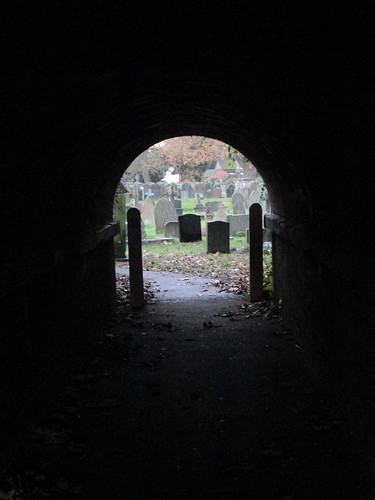
South Staffordshire: Penkridge, pedestrian tunnel under railway with churchyard in the background.
My new friend was travelling to Birmingham and, by dashing up the stairs to platform 1, he just caught a train which arrived as we approached. I had time to negotiate with the touch-screen ticket machine which was running new software, presumably because the Train Operating Company at Penkridge has recently changed.
The previous 'London Midland' franchise was taken over by West Midlands Trains on 10th December 2017. There's a useful Wikipedia article here. The new company is operating two 'brands'. Trains within the West Midlands form the 'West Midlands Trains' brand whilst 'long-distance' trains to London and Liverpool form the 'London Northwestern Railway' brand. Although I'd seen a picture of a West Midlands Trains trainset in their new livery, the trains I saw during the day all retained their old 'London Midland' livery.
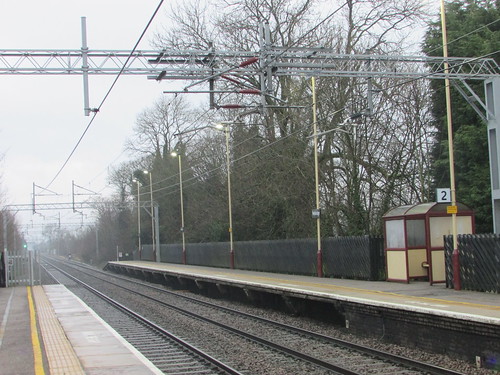
Trip to Merseyside 6-Jan-2018: A gloomy Penkridge Station, looking towards Stafford.
The journey to Liverpool Lime Street was on-time. When I saw that our arrival was into one of the low-numbered platforms usually reserved for local trains, I remembered that Liverpool Lime Street is in the throes of an Upgrade Programme which will create one new platform and lengthen two others. There's a little more about this in the section 'Liverpool Lime Street Upgrade'. I purchased an 'All-Zones 1-day Saveaway' giving unlimited bus, train and ferry use in Merseyside and descended to Liverpool Lime Street Low Level to catch a Merseyrail service two stops to James Street.
A few minutes later, I was emerging into sunshine at James Street and, although it wasn't exactly warm, the walk to the Museum of Liverpool was pleasant enough. I'm secretary of the Old Locomotive Committee (there are lots of posts about the 'Old Locomotive' in question - 'Lion' here) so, when in Liverpool, I like to check-up on the Museum's 'star exhibit'. All was normal (although I'm never very happy to see a steam locomotive 'stuffed and mounted').
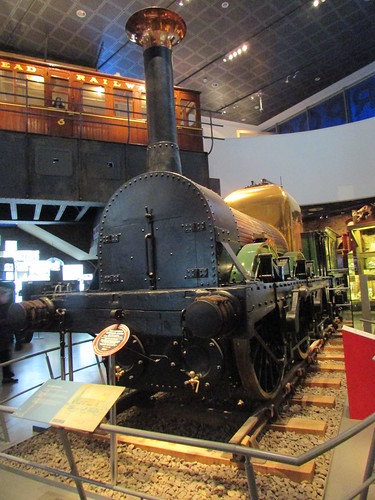
'Lion' Exhibit, Museum of Liverpool.
A display case in the foyer now covers the Liverpool tram system. I was impressed by the detailed model of a 1936 tram as that's the design of tram I remember seeing on my early trips to Liverpool.
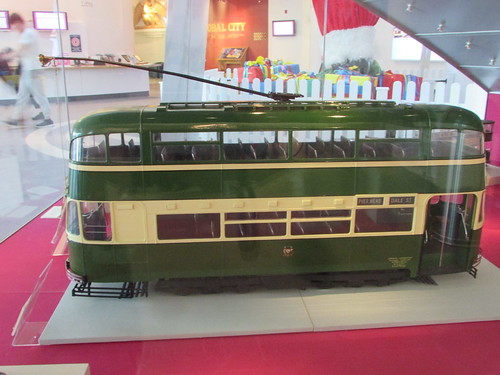
Tramways Exhibit, Museum of Liverpool with model of 1936 'Green Goddess' tram.
This year, I was surprised to find the waterfront between the Museum and the Ferry Landing Stage hosting a Fun Fair, with a few hardy ride operators open for business - the wind was noticeably keener near the water.
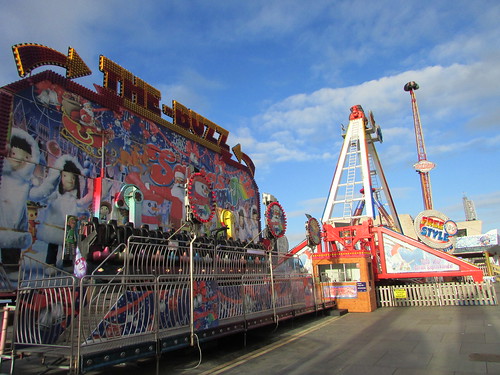
Liverpool Waterfront with Fun Fair.
I was probably even more surprised by the appearance of the iconic Liver Building and its clock. The clock face facing the museum was missing both hands: that facing the river was working but 20 minutes fast!
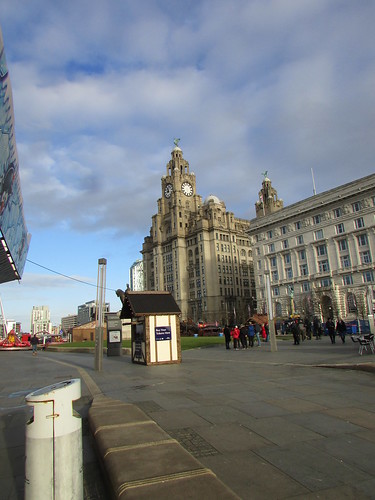
Trip to Merseyside 6-Jan-2018: Liverpool Waterfront.
It's become a tradition for me to take the 'Ferry cross the Mersey', so I boarded 'Snowdrop' on the 11 o'clock sailing still, I'm afraid, in her 'Dazzle' livery. I've complained before about Sir Peter Blake's interpretation of 'Dazzle Painting' which bears only a slight relationship to the actual livery applied to many ships in World War I (see the post here).
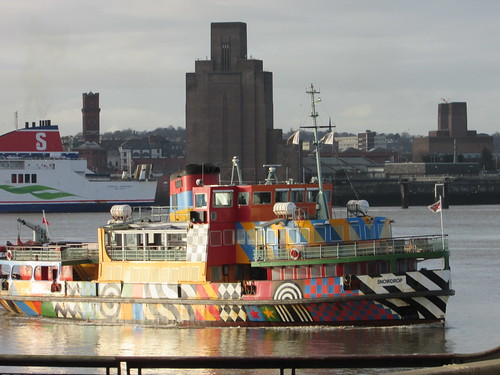
Trip to Merseyside 6-Jan-2018: Mersey Ferry 'Snowdrop' approaching Pierhead in bright sunshine.
Of course, I positioned myself on the open promenade deck near the bow, despite the sharp wind. I never tire of the views of the the old docks and modern shipping. As we slipped away from Pierhead, we were preceded by 'Ro-Ro' (Roll-on, Roll-off) ferry 'Stena Mersey' heading for Belfast which joined a procession of departing ships.
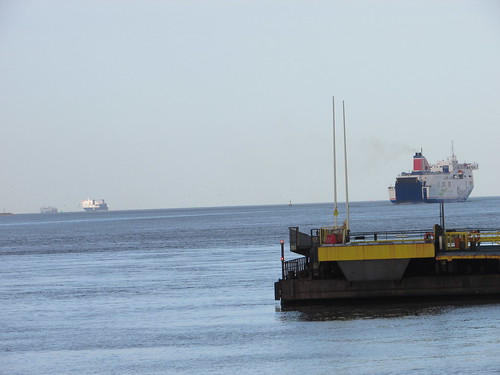
Trip to Merseyside 6-Jan-2018: Three ships leaving Liverpool just after 11.00 a.m. (L-R) Unidentified, 'Seatruck' 'Ro-Ro' ferry to Dublin, 'Stena Mersey' 'Ro-Ro' ferry to Belfast.
Whereas the gangway at Pierhead is now hydraulically operated, at Seacombe (and Woodside) gangways remain counterbalanced and manually operated. The 'shore party' at each location is now one man to handle the bow mooring line, the gangway and the gate on the landing stage which allows passengers onto the ferry. On the ferry, two deckhands appear to handle all activities. In the tricky waters of the Mersey, safe ferry docking depends upon good co-ordination between the Captain, the deckhands and the shore man. According to the state of the tide, the ferry docks either facing upstream or facing downstream.
We docked at Seacombe Landing stage, landed a handful of passengers and boarded others.
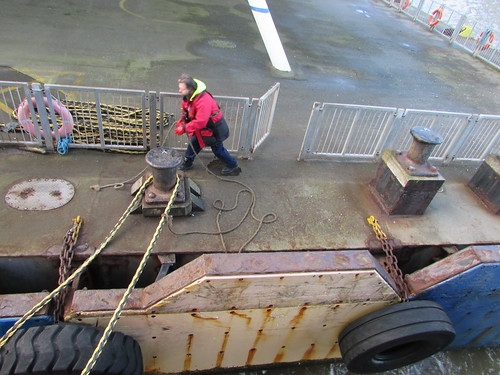
Trip to Merseyside 6-Jan-2018: Docking at Seacombe Landing Stage.
'Snowdrop' then headed upstream, passing 'Ro-Ro' ferry 'Stena Precision' moored at Twelve Quays Ferry Terminal and made a loop to starboard so as to dock with the ferry facing downstream.
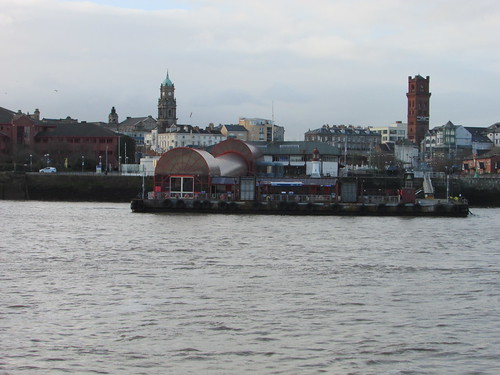
Trip to Merseyside 6-Jan-2018: Birkenhead Woodside Landing Stage.
A section of gunwhale on either side of the ship, fore and aft has a sliding section which, when pushed open, allows the gangway to drop onto the main deck. A sign warns passengers 'In the interest of safety please stand behind the brass line until gangway is lowered' and a (rather tarnished) brass strip is set in the decking. I found this a delightful survivor from more innocent, less Health and Safety obsessed times.
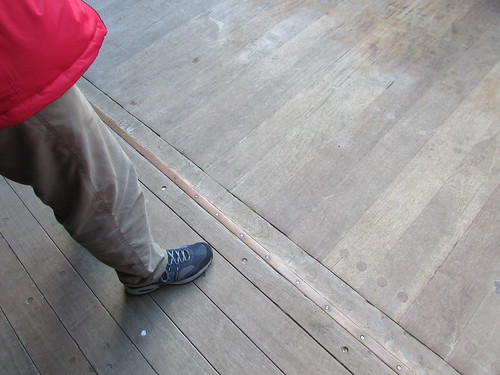
Trip to Merseyside 6-Jan-2018: Passengers obediently stand behind the brass line, waiting to disembark.
I made my way ashore and walked to Hamilton Square station, with its impressive tower, listed Grade II. Pevsner comments:-
Station. c1886. By G.E.Grayson. Brick and terracotta. Italianate style. Hamilton Street elevation has hydraulic tower on angle, and pedimented central block of booking hall, with triple round-arched windows in apex and inserted lower openings. Deep cornice band of terracotta panels. Glazed roof to booking hall. Glazed canopy projects from this block and from the tower. 3-bay range to left with louvred windows to right and doorway to left, possibly generator house. 3 paired round-headed windows above, and a row of oculi over. Terracotta cornice and mouldings to openings. Prominent 4-stage tower with round arched windows in lower stage with clusterd shafts. Triple round-arched windows above, then single round-arched windows and ribbed panelled band with paired segmentally arched windows, some now blocked. Cornice above, then giant segmentally-arched recesses housing 2 tiers of mullioned and transomed windows with enriched terracotta detail. Machicolated embattled parapet then high round arched recesses with paired windows and oculi. Clustered shafts at angles form pinnacles. Balustraded parapet and small lead fleche. 3 bay 3-storeyed return elevation to Bridge Street with continuous arcading at each level. Interior of booking hall has glazed tiled walls and queen post and collar roof with wrought iron ties. The station was built as part of the Mersey railway and Mersey rail tunnel, which opened in 1886. The engineers were James Brunlees and Charles Douglas Fox.
(The Buildings of England: Pevsner N and Hubbard E: Cheshire: Harmondsworth: 1971-).
The underground platforms have always been accessed by lifts which were originally hydraulically-operated (the tower housed the hydraulic accumulator) but are now electric. The station was refurbished in 2014-2015.
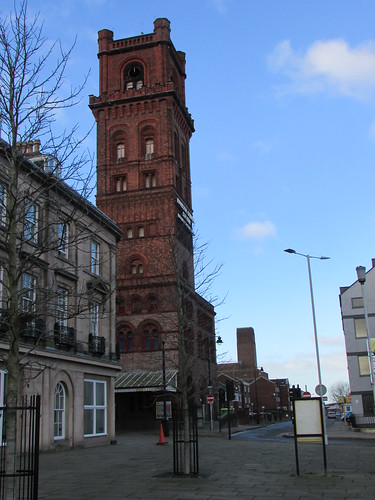
Trip to Merseyside 6-Jan-2018: Hamilton Square Station.
I took a New Brighton Train from Platform 3. The current trains are Class 507 and 508/1 3-car units built between 1978 and 1980. Although these trainsets are elderly, an Alstom refurbishment programme between 2002 and 2005 has improved the "passenger experience". However, in 2016, Merseytravel placed an order with Swiss train builder Stadler which will replace the entire fleet with Class 777 METRO 4-car sets by 2021.
Passing through Birkenhead, I noticed the top of the superstructure of a navy ship in the Cammell Laird Yard (which is discussed in the section Bidston Graving Dock of my post here). On my return home, I identified the ship as 'RFA Ford Austin' using the Ship AIS page here.
I was soon at New Brighton Station. Merseyrail make up for the fairly spartan trains by having stations which are staffed, warm, well-lit, provided with clean, working toilets and, usually, a shop or refreshment facilities.
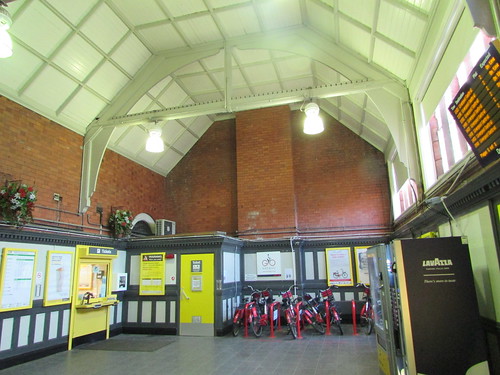
Trip to Merseyside 6-Jan-2018: Booking Hall at New Brighton Station.
I set off on foot down Victoria Road towards the estuary, pausing at Victoria Road Fish and Chips for a take-away portion of excellent chips which lasted me to the Promenade. The massive, red-painted container cranes at the new deep-water port at Seaforth called 'Liverpool 2' dominate the view across the river. I briefly discussed the building of this facility, to handle post-Panamax vessels, in the post Notes on Liverpool and its Docks and I think I first saw these cranes in December 2016, as reported here.
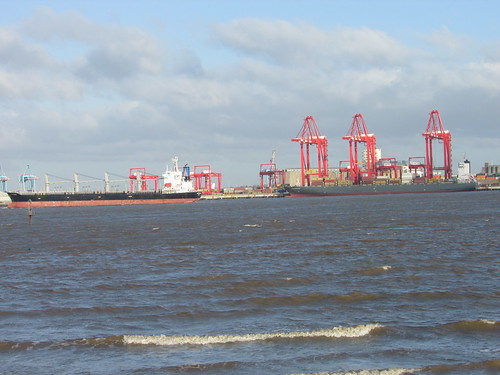
Trip to Merseyside 6-Jan-2018, view from New Brighton Promenade across river: (L:) Panamanian-registered bulk carrier 'Lord Nelson' (28,653 DWT) heads out to sea, (R:) Liberian-registered container ship 'Songa Antofagasta' (35,534 DWT) moored at 'Liverpool 2'.
Although the new quay is open, there have been problems with the unexpected appearance of a sink-hole in the North Quay and locals have grumbled that they haven't seen many super-sized container ships yet. Needless to say, a Peel Ports spokesman remained confident for the future of this facility. The modern Floral Pavilion lies on the landward side of the promenade.
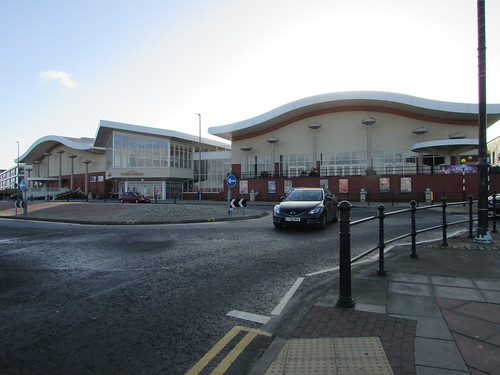
Trip to Merseyside 6-Jan-2018: Floral Pavilion Theatre, Promenade, New Brighton.
Before I made my way back to the railway station, I watched 'Oramalia' heading out to sea, following 'Lord Nelson'.
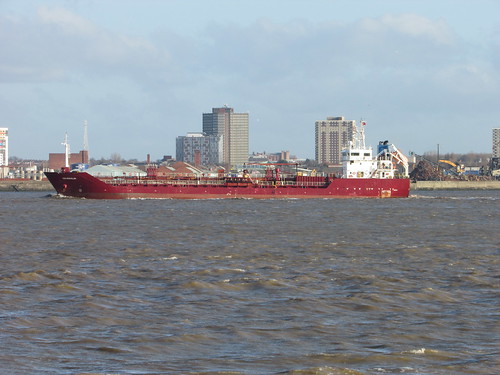
Trip to Merseyside 6-Jan-2018: Viewed from New Brighton Promenade, Gibraltar-registered oil/chemical tanker 'Oramalia' (6,863 DWT) heads out to sea.
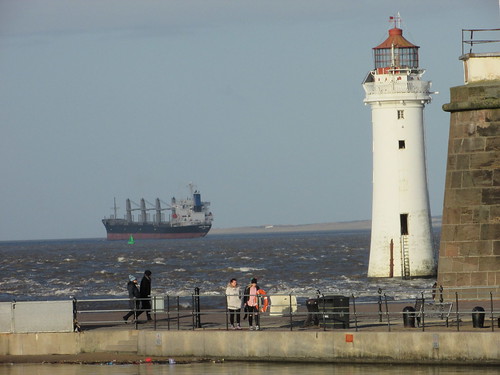
Trip to Merseyside 6-Jan-2018: Panamanian-registered bulk carrier 'Lord Nelson' 28,653 DWT heads out to sea with the former New Brighton Lighthouse on the right.
I arrived at the station in time to see a train just leaving. I spent the short time waiting for the next service taking pictures around the station.
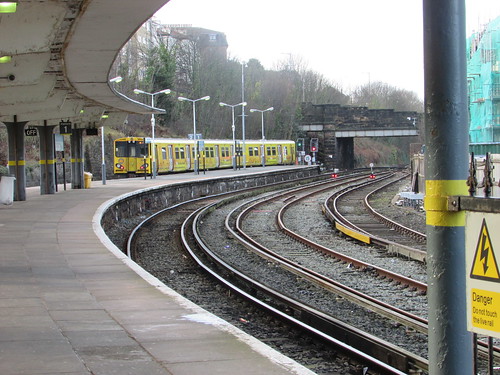
Trip to Merseyside 6-Jan-2018: Class 508 'Merseyrail' service leaving New Brighton station.
The train returned me quickly to the City and I alighted at Liverpool Lime Street station where escalators took me to the main line concourse. I'd originally intended to explore a little more but I was tired from the walking and the temptation of a Wolverhampton-bound train standing in the new platform 8 proved too great so, after a quick photograph at the platform end, I boarded the train home.
Liverpool Lime Street station Upgrade
When complete, the Upgrade with give Lime Street one extra platform and two lengthened platforms. Originally, the wide island platform 7/8 carried a carriage road allowing taxis and other vehicles direct access to trains. This was a common feature at important stations when I was growing up but appears to have fallen out of favour (although on my 2009 visit to Howrah station in Kolkata I was delighted to find the carriage road still in use). For some years, the carriage road at Lime Street had been used for various buildings, including the Virgin Trains First Class Lounge since the Virgin services to London used platform 7. All these buildings have been demolished (the Virgin First Class Lounge has been relocated on the concourse). Eliminating the space used by the carriage road has allowed the island platform to be narrowed, leaving room for an additional track and platform which will be the new platform 7, increasing subsequent platform numbers by one.
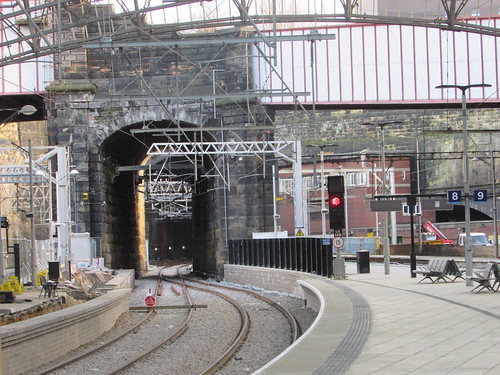
Trip to Merseyside 6-Jan-2018: Liverpool Lime Street Station. L: New platform 7 under construction, R: New platform 8 in use.
My train departed from the new platform 8 but work on the new platform 7 was still under way. There's a colourful (but inaccurate) computer-generated publicity image showing the final arrangement reproduced below.
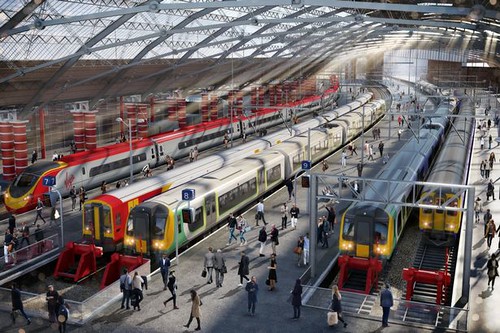
Computer image of Liverpool Lime Street after Upgrade.
Postscript
Although I returned home from Liverpool Lime Street without incident, the following day Network Rail closed the station to all trains for an estimated two days because of the discovery of dangerous corrosion in an Overhead Line structure affecting all lines.
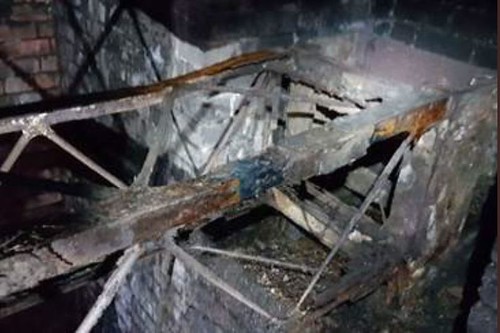
Corroded OLE gantry on approach to Lime Street pictured by RMT Union.
This is not the only case of Network Rail's shortcomings affecting Lime Street. Less than a year earlier, in February 2017, the station was closed for a week following partial collapse of the stone-built retaining wall in Edge Hill Cutting. In November 2017 the Rail Accident Inspection Branch published its report on the incident which you can find 17/2017.
Related posts on other websites
Although the links worked at the time this post was published, changes made by that website's owner may 'break' the link.
West Midlands Trains.
RAIB Report 17/2017.
Related posts on this website
As I comment above, 'Merseyside' is a recurring theme in this blog. Your can find all my posts about Merseyside here.
Posts on the Old Locomotive Committe are here.
My photograph albums
Where necessary, clicking on an image above will display an 'uncropped' view or, alternately, pictures may be selected, viewed or downloaded, in various sizes, from the album covering this trip:-
Trip to Merseyside.

















































